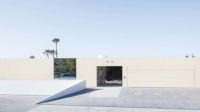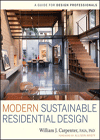Along with a crane, virtually all the structural and material components of “No Footprint House” reached its site—in southwest Costa Rica’s rain forest—in a single truckload. An 18-wheel rig delivered it from the country’s Central Valley, where the building parts were prefabricated, to a 1.24-acre parcel, along a gravel road in the jungle.
Additional Content:
Jump to credits & specifications
There, the 1,500-square-foot steel-frame two-bedroom house was assembled. Most striking is its sheathing, or veil, of slatted-wood screens, recalling the visual lightness of a cricket cage. Accentuating the effect, the building hovers on concrete piers, touching lightly on the ground. A motorized, counterweighted mechanism opens up large folding sections of the slatted wrapper (which slants inward, rather than hanging vertically, to fend off sun and rain). With operable panels retracted, the living spaces merge with the outdoors, as if afloat in the rain forest.
Inside, an open plan flows around a central core containing kitchen, bathrooms, and storage. Textile curtains and sliding glass panels, beneath a clerestory of mosquito screening, can separate sleeping from cooking/dining/living areas.
The assembly process took a year, including finishes and connections to the nation’s public water and energy grid (powered almost entirely by renewable resources). But Oliver Schütte, the German-born architect who designed the project with his Costa Rica–based firm, A-01, intends to reduce on-site construction to four weeks for future No Footprint Houses (NFHs or Casas Sin Huella). “This was a prototype, the first we’ve built,” he explains, “so it involved lots of investigation, learning, and testing along the way.” His goal is to produce a series, in three different sizes, adaptable through the “NFH Toolbox,” or catalogue of prefabricated components and finishes, to suit each owner, site, and budget. When Schütte founded A-01, in 2005, with his life partner, cultural anthropologist Marije van Lidth de Jeude, they combined a newly formed architecture/urban design practice and nonprofit foundation—“a think tank,” he says, “for social, environmental, and economic sustainability.” In that spirit, they hope to make versions of NFH available as affordable housing.
For the project’s first realization, costing about $93 per square foot, the clients were a Dutch couple. They told A-01 they were drawn to the design’s spatial flexibility and dynamic, air-conditioner-free climate control. Completed in December 2018, on the outskirts of a village, the house immerses the owners in the rain forest with remarkable openness and privacy. The cross-ventilation (assisted by ceiling fans) and building configuration have reportedly kept them perfectly comfortable throughout heat, humidity, and the rainy season.
The next NFH is under way on the Pacific Coast. Most future iterations will use demountable (truly footprint-free) foundations. And Schütte, who worked with Peter Eisenman and Rem Koolhaas before moving to Costa Rica 15 years ago, is already pondering an urban No Footprint Tower. Stay tuned.
CreditsArchitect: A-01 (A Company / A Foundation) Costa Rica / Netherlands +506 8304.3087
Personnel in architect's firm who should receive special credit: Oliver Schütte (lead architect), Marije van Lidth de Jeude (typology research), José Pablo González, Mauricio Rodríguez, Misael Rodríguez, Ronald Carvajal Soto (design team)
Engineers: MEP engineering: Consost Structural engineering: Ingeniería Cañas
General contractor: SLO Studiolocal
Photographer: Fernando Alda |
Specifications |








